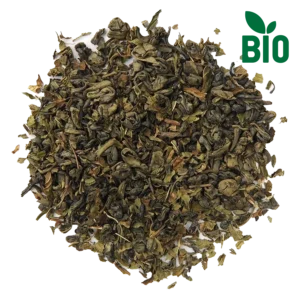Think of a plant that brings the freshness of the Mediterranean to your kitchen. Many will think of spearmint, (Mentha Spicata) and not unfairly! Apart from cooking though, it has a lot to offer. In this article, we discover the hidden world of spearmint. We will learn how this herb improves our lives, we will reveal its medicinal properties and its value in our everyday life. Get ready to discover how this herb can enrich your health and taste. Enter a world where nature meets wellness.
Photo luknaja
“ Spearmint, with its gentle aroma and powerful properties, is the natural link between the art of cooking and the wisdom of nature. In one little leaf… a great treasure “
This herb has a rich history dating back to ancient Greece. Its name comes from the word ‘eidiosmos’, which means ‘pleasant smell’, and it is a ‘close relative’ of mint. Spearmint has always been used for both culinary and medicinal purposes. In the kitchen, it adds flavour and aroma to a variety of dishes. In traditional medicine, it was known for its rejuvenating properties.
Through the centuries, spearmint has managed to maintain its place in culture and cuisine. From ancient Greek symposia to modern kitchens, its presence is constant. Today, it continues to be a beloved ally in healthy eating and natural healing.
Spearmint’s rich composition of vitamins and minerals, as well as its antioxidant properties, make it an extremely beneficial herb for nutrition and health.

This herb, known for its refreshing properties, has an important role in traditional and modern natural medicine. Research shows that it contains antioxidant, antimicrobial and antispasmodic components. These properties make it useful for various ailments and for improving general health.
Here are some of its key therapeutic uses, supported by both traditional medicine and modern studies:
Before adding new ingredients or treatments to your daily routine, it is always wise to seek the advice of your doctor.
Tips: Use fresh mint for better flavor. Add it at the end of cooking to preserve its flavor.

Instructions:
If using dried mint, measure about a teaspoon for each cup of tea.
Heat water to a temperature of 90°C (We estimate one cup to be about 250 ml of water).
Put the mint in a teapot or cup.
Add hot water.
Allow the mint to steep for about 5-10 minutes, keeping your pot covered.
Drain the tea to remove the mint leaves.
Add honey or lemon for extra flavor, if desired.
Photo Deyan Georgiev
Attention:
With these instructions, you are ready to enjoy a delicious and aromatic spearmint tea!
Through this article, we have highlighted the multidimensional uses and benefits of spearmint. Spearmint is not just an aromatic herb, but a natural treasure that can enrich our daily lives. We encourage you to explore mint further and incorporate it into your kitchen, your health routine or even growing it in your garden. The complexity of its flavors and its healing properties are here for you to discover and enjoy!
Source
These sources provide in-depth information and analysis on spearmint and its many uses and benefits. Their study will be useful for those who wish to gain a deeper understanding of the properties and applications of spearmint.
https://pubmed.ncbi.nlm.nih.gov/34087400/
Subscribe to our newsletter to stay informed about herbs, recipes, exclusive offers, and receive a 15% discount on your first order!

Ευχαριστούμε πολύ τα παρακάτω websites για τη συνδρομή τους σε επιπρόσθετο, ελεύθερο φωτογραφικό υλικό (free stock) που χρησιμοποιείται στην ιστοσελίδα μας:
Pixabay.com
Pexels.com
Unsplash.com
Freepik.com
Canva.com
Adobe.com
Σταύρος Δεβεράκης (Φωτογράφος)
Many thanks to the following websites for their subscription to additional, free stock photography used on our website:
Pixabay.com
Pexels.com
Unsplash.com
Freepik.com
Canva.com
Adobe.com
Stavros Deverakis (Photographer)